Simple lightning protection - implementation for 3g modems and TVs
This material is an addition and practical illustration to the previous article.
Wood core transformer or lightning protection for computers and televisions
With the onset of warm weather, the workplace moved to the holiday village.
Of course, I had to forget about the beautiful stationary wired Internet and enjoy the charms of 3g.
In the first thunderstorm, by disconnecting the modem, I began to attend thoughts: wouldn’t I try the same or similar lightning protection as described earlier, but for a 3g modem?
Theoretically, everything should be wrong and should not work, but the attempt was made.
')
The main problem is the earth, that is, the grounding of the computer with the antenna connected (without an antenna, communication is almost impossible).
In the previous material, the danger of the problem was designated as exceptionally high, and somewhere it is.
Plus, the danger of damage to the modem by a strong field of electromagnetic waves when lightning is discharged.
The situation in the illustrations.
Antenna in the "combat position":
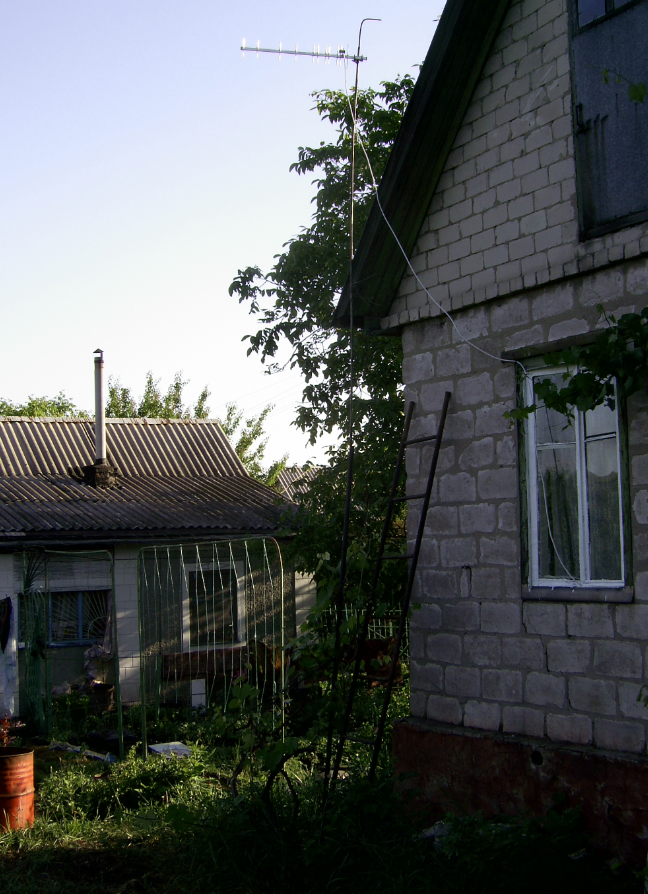
In the picture you can see that the antenna mast is dug into the ground (at the same time it performs the function of support for the grapes).
But where does the grounding on the antenna cable sheath come from:
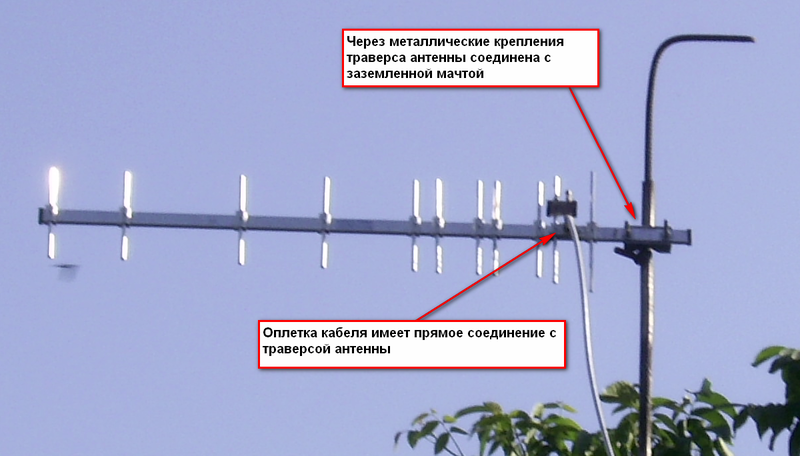
Next, the computer is grounded through the circuit: cable sheath -> common modem wire -> USB ground -> common wire (case) of the computer.
So, in such a system there is a threat in case of a thunderstorm number 1 in the form of leaking lightning currents through the ground into a computer with all the unpleasant consequences that follow.
There is a second threat. Please note: the antenna is set to receive signals with vertical polarization (well, that is, those with an electric field directed vertically).
Again, in the previous post there is an illustration where it is very clearly seen that the electric field in the electromagnetic field from the lightning is also directed vertically.
Thus, when a lightning strike at the antenna output there is a risk of significant voltages. The situation is the same as with the communication line - antiphase voltage, or threat number 2.
It was very tempting to break the antenna cable just to turn on the transformer from a twisted pair, but then everything is theoretically very bad.
Bad number 1. It seems like the standard twisted pair operates at frequencies up to 125 Megahertz. The CDMA signal is 800 MHz, that is, a significant loss in the transformer must be expected.
Number 2 is bad. The characteristic impedance of the cable is 75 Ohms, the twisted pair is 100 Ohms.
Step back a little to the side. Everywhere there are many definitions of wave resistance, all sorts of formulas, but it seems that this is a kind of abstraction, a virtual parameter.
Dispel this.
Imagine that we have in one hand - the battery, the most common.
Now imagine that in the second hand, we hold the end of soooo long line of communication.
We do a simple operation: connect the battery to the line. What will happen?
A wave will go into the line, “charging” the line with the energy of its electromagnetic field, the more we hold the battery connected to the line, the more part of the line will be charged with energy.
You can figuratively say that the wave "sucks" energy from the battery and transmits it to the line.
And how does the situation look like in terms of battery? The current is simply flowing, as if a resistor were attached to the battery, and the resistance of this resistor is equal to the characteristic impedance of the line.
If there are areas with a different characteristic impedance on the path of the wave in the cable, the wave is reflected from them.
The ends of the cable and the circuit in the cable are in fact also sections with a different characteristic impedance: the open end of the cable is infinite resistance, the circuit is zero.
For radio signals, reflections in the cable lead mainly to signal loss at the cable output.
But for digital signals, reflections lead to distortion of information and often even to the impossibility of communication.
Extremely critical to Ethernet impedance. A strong mismatch at the ends of the cable immediately “extinguishes” the connection completely, and it looks like this: the link is 100 megabits on, there is no ping
Let's return to the lightning protection.
So, everything is bad - the twisted pair is relatively low-frequency, the characteristic impedance is different, also symmetric, unlike the antenna cable.
An attempt was made to manufacture a transformer on a long line from an antenna cable, but the attempt was unsuccessful - no connection, signal level - zero.
Just for good luck, exactly the same transformer on a long twisted-pair line was connected to the line break, as described earlier.
The result was very surprised:
Signal level WITHOUT lightning protection transformer: -75 dBm
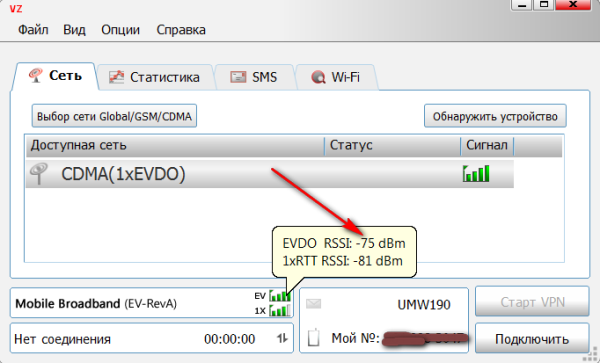
with a transformer connected to the antenna cable break
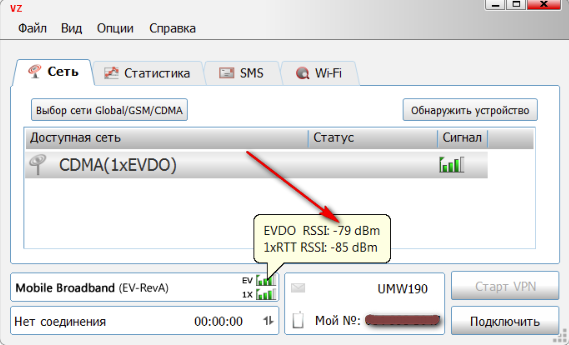
Observation of the level showed that the transformer introduces losses of 3-4 dBm, which is not critical even on not very strong signals.
On the quality of communication, speed, and so forth, the influence is not noticed.
Heating of the modem is normal, nothing has changed.
Design.
Schematically:

The design itself was made using standard antenna connectors (suitable for television).
It turned out like this:

And the whole structure is connected
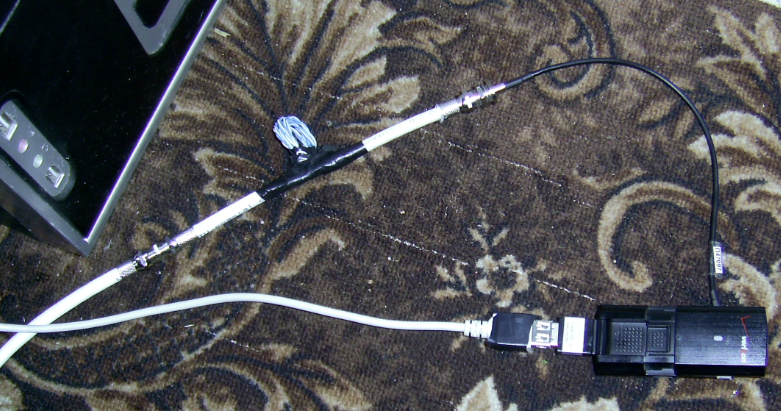
An important feature : the system is critical to polarity.
In my case, in the very first experiment, the transformer introduced a loss of 6 dBm when I swapped the wires of a twisted pair going to the modem - the attenuation dropped to 3 dBm.
The phenomenon arises, most likely due to the fact that we dock a symmetric transformer with an unbalanced coaxial cable.
And a little moment. The 1: 1 design is suitable for TVs, if you screw the male and female antenna connectors onto the ends of the cable, something like this
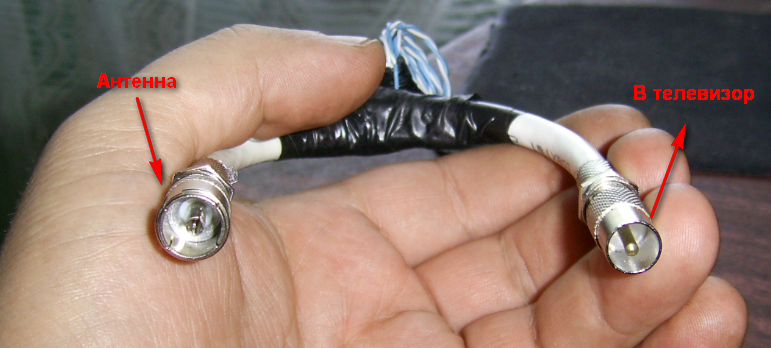
What was the result?
1. When connecting the cable, it stopped beating current (and the fear of damaging something with such connections disappeared).
2. The need to pull out a pigtail from a modem during a thunderstorm disappeared, constantly thinking about how many such interruptions the connector would break.
Wood core transformer or lightning protection for computers and televisions
With the onset of warm weather, the workplace moved to the holiday village.
Of course, I had to forget about the beautiful stationary wired Internet and enjoy the charms of 3g.
In the first thunderstorm, by disconnecting the modem, I began to attend thoughts: wouldn’t I try the same or similar lightning protection as described earlier, but for a 3g modem?
Theoretically, everything should be wrong and should not work, but the attempt was made.
')
The main problem is the earth, that is, the grounding of the computer with the antenna connected (without an antenna, communication is almost impossible).
In the previous material, the danger of the problem was designated as exceptionally high, and somewhere it is.
Plus, the danger of damage to the modem by a strong field of electromagnetic waves when lightning is discharged.
The situation in the illustrations.
Antenna in the "combat position":

In the picture you can see that the antenna mast is dug into the ground (at the same time it performs the function of support for the grapes).
But where does the grounding on the antenna cable sheath come from:

Next, the computer is grounded through the circuit: cable sheath -> common modem wire -> USB ground -> common wire (case) of the computer.
So, in such a system there is a threat in case of a thunderstorm number 1 in the form of leaking lightning currents through the ground into a computer with all the unpleasant consequences that follow.
There is a second threat. Please note: the antenna is set to receive signals with vertical polarization (well, that is, those with an electric field directed vertically).
Again, in the previous post there is an illustration where it is very clearly seen that the electric field in the electromagnetic field from the lightning is also directed vertically.
Thus, when a lightning strike at the antenna output there is a risk of significant voltages. The situation is the same as with the communication line - antiphase voltage, or threat number 2.
It was very tempting to break the antenna cable just to turn on the transformer from a twisted pair, but then everything is theoretically very bad.
Bad number 1. It seems like the standard twisted pair operates at frequencies up to 125 Megahertz. The CDMA signal is 800 MHz, that is, a significant loss in the transformer must be expected.
Number 2 is bad. The characteristic impedance of the cable is 75 Ohms, the twisted pair is 100 Ohms.
Step back a little to the side. Everywhere there are many definitions of wave resistance, all sorts of formulas, but it seems that this is a kind of abstraction, a virtual parameter.
Dispel this.
Imagine that we have in one hand - the battery, the most common.
Now imagine that in the second hand, we hold the end of soooo long line of communication.
We do a simple operation: connect the battery to the line. What will happen?
A wave will go into the line, “charging” the line with the energy of its electromagnetic field, the more we hold the battery connected to the line, the more part of the line will be charged with energy.
You can figuratively say that the wave "sucks" energy from the battery and transmits it to the line.
And how does the situation look like in terms of battery? The current is simply flowing, as if a resistor were attached to the battery, and the resistance of this resistor is equal to the characteristic impedance of the line.
If there are areas with a different characteristic impedance on the path of the wave in the cable, the wave is reflected from them.
The ends of the cable and the circuit in the cable are in fact also sections with a different characteristic impedance: the open end of the cable is infinite resistance, the circuit is zero.
For radio signals, reflections in the cable lead mainly to signal loss at the cable output.
But for digital signals, reflections lead to distortion of information and often even to the impossibility of communication.
Extremely critical to Ethernet impedance. A strong mismatch at the ends of the cable immediately “extinguishes” the connection completely, and it looks like this: the link is 100 megabits on, there is no ping
Let's return to the lightning protection.
So, everything is bad - the twisted pair is relatively low-frequency, the characteristic impedance is different, also symmetric, unlike the antenna cable.
An attempt was made to manufacture a transformer on a long line from an antenna cable, but the attempt was unsuccessful - no connection, signal level - zero.
Just for good luck, exactly the same transformer on a long twisted-pair line was connected to the line break, as described earlier.
The result was very surprised:
Signal level WITHOUT lightning protection transformer: -75 dBm

with a transformer connected to the antenna cable break

Observation of the level showed that the transformer introduces losses of 3-4 dBm, which is not critical even on not very strong signals.
On the quality of communication, speed, and so forth, the influence is not noticed.
Heating of the modem is normal, nothing has changed.
Design.
Schematically:

The design itself was made using standard antenna connectors (suitable for television).
It turned out like this:

And the whole structure is connected

An important feature : the system is critical to polarity.
In my case, in the very first experiment, the transformer introduced a loss of 6 dBm when I swapped the wires of a twisted pair going to the modem - the attenuation dropped to 3 dBm.
The phenomenon arises, most likely due to the fact that we dock a symmetric transformer with an unbalanced coaxial cable.
And a little moment. The 1: 1 design is suitable for TVs, if you screw the male and female antenna connectors onto the ends of the cable, something like this

What was the result?
1. When connecting the cable, it stopped beating current (and the fear of damaging something with such connections disappeared).
2. The need to pull out a pigtail from a modem during a thunderstorm disappeared, constantly thinking about how many such interruptions the connector would break.
Source: https://habr.com/ru/post/144115/
All Articles